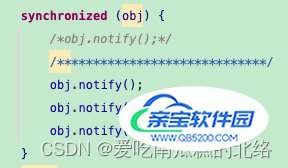Java使用wait/notify实现线程间通信下篇
爱吃南瓜糕的北络 人气:0上一节针对wait/notify实现线程间通信的基本概念做了讲解(Java使用wait/notify实现线程间通信上篇),本节继续针对wait/notify实现线程间通信的其他知识点及特性进行讲解。
1. 当 interrupt() 方法遇到 wait() 方法
当线程调用锁对象的wait() 方法使线程呈等待状态时,调用线程对象的 interrupt() 方法会出现 InterruptedException 异常。
public class ThreadC7 {
@Test
public void test1() {
try {
Object obj = new Object();
ThreadC7A threadC7A = new ThreadC7A(obj);
threadC7A.start();
Thread.sleep(2000);
threadC7A.interrupt();
} catch (Exception e) {
e.printStackTrace();
}
}
}
class ServiceC7 {
public void testMethod(Object obj) {
try {
synchronized (obj) {
System.out.println("begin wait");
obj.wait();
System.out.println("begin end");
}
} catch (Exception e) {
e.printStackTrace();
System.out.println("出现异常了,wait状态的线程被interrupt了!");
}
}
}
class ThreadC7A extends Thread {
private Object obj;
public ThreadC7A(Object obj) {
this.obj = obj;
}
@Override
public void run() {
ServiceC7 serviceC7 = new ServiceC7();
serviceC7.testMethod(obj);
}
}执行结果:

2. notify() 只通知一个线程
调用方法notify()一次只随机通知一个线程进行唤醒。
public class ThreadC8 {
@Test
public void test() {
Object obj = new Object();
ThreadC8A threadC8A = new ThreadC8A(obj);
threadC8A.setName("threadC8A");
threadC8A.start();
ThreadC8B threadC8B = new ThreadC8B(obj);
threadC8B.setName("threadC8B");
threadC8B.start();
ThreadC8C threadC8C = new ThreadC8C(obj);
threadC8C.setName("threadC8C");
threadC8C.start();
try {
Thread.sleep(1000);
} catch (Exception e) {
e.printStackTrace();
}
synchronized (obj) {
obj.notify();
}
while (Thread.activeCount() > 1) {
}
}
}
class ServiceC8 {
public void service(Object obj) {
try {
synchronized (obj) {
String threadName = Thread.currentThread().getName();
System.out.println("begin wait,Thread Name:[" + threadName + "]");
obj.wait();
System.out.println("end wait,Thread Name:[" + threadName + "]");
}
} catch (Exception e) {
e.printStackTrace();
}
}
}
class ThreadC8A extends Thread {
private Object obj;
public ThreadC8A(Object obj) {
this.obj = obj;
}
@Override
public void run() {
ServiceC8 serviceC8 = new ServiceC8();
serviceC8.service(obj);
}
}
class ThreadC8B extends Thread {
private Object obj;
public ThreadC8B(Object obj) {
this.obj = obj;
}
@Override
public void run() {
ServiceC8 serviceC8 = new ServiceC8();
serviceC8.service(obj);
}
}
class ThreadC8C extends Thread {
private Object obj;
public ThreadC8C(Object obj) {
this.obj = obj;
}
@Override
public void run() {
ServiceC8 serviceC8 = new ServiceC8();
serviceC8.service(obj);
}
}执行结果:

程序运行的效果如图所示,可以看出方法notify()仅随机唤醒一个线程。
当多次调用notify()方法时,会随机将等待wait状态的线程进行唤醒。更改代码如下:

再次运行,程序运行效果如图所示,可以看出所有的线程全部被唤醒。

多次调用notify()方法可唤醒全部WAITING中的线程。
3. notifyAll() 唤醒所有线程
前面的示例中通过多次调用 notify() 方法来实现唤醒3个线程,但并不能保证系统中仅有3个线程,也就是若notify()方法的调用次数小于线程对象的数量,会出现有部分线程对象无法被唤醒的情况。为了唤醒全部线程,可以使用notifyAll()方法。
更改代码如下:

再次运行,程序运行效果如图所示,可以看出所有的线程全部被唤醒。

4. 方法 wait(long)的使用
带一个参数的wait(long) 方法的功能是等待某一时间内是否有现成对锁进行唤醒,如果超过这个时间则自动唤醒。
public class ThreadC9 {
@Test
public void test() {
Object obj = new Object();
ThreadC9A threadC9A = new ThreadC9A(obj);
threadC9A.start();
while (Thread.activeCount() > 1) {
}
}
}
class ThreadC9A extends Thread {
private Object obj;
public ThreadC9A(Object obj) {
this.obj = obj;
}
@Override
public void run() {
try {
synchronized (obj) {
long startTime = System.currentTimeMillis();
System.out.println("begin wait,time:[" + startTime + "]");
obj.wait(5000);
long endTime = System.currentTimeMillis();
System.out.println("end wait,time:[" + endTime + "] takes " + (endTime - startTime) + " ms");
}
} catch (Exception e) {
e.printStackTrace();
}
}
}执行结果:

通过执行结果可以看出,在经过5000ms后,线程被唤醒。
加载全部内容